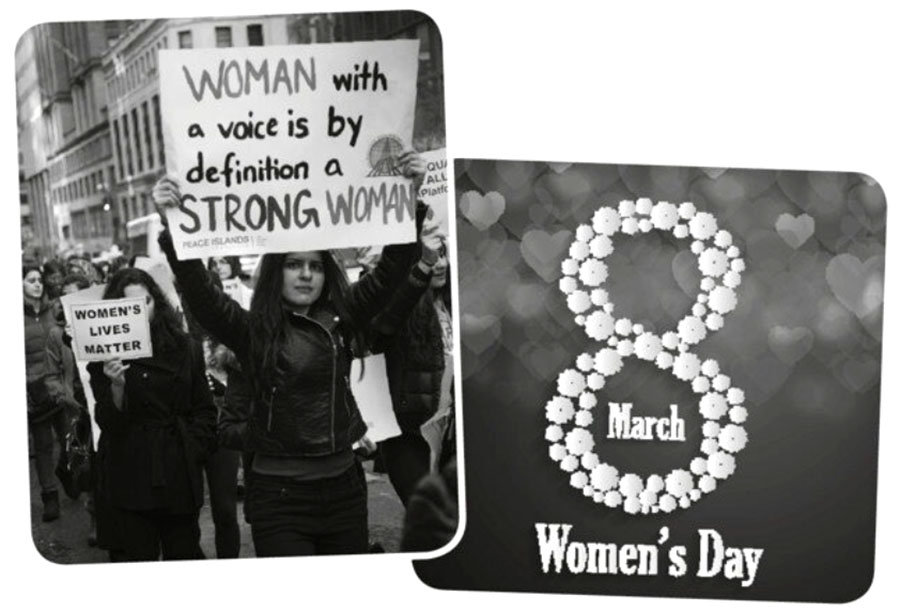1. Listen to a student doing the task below. Which of the four prompts (A-D) does she not mention?
Look at the pictures. Then talk for about one minute about how people in your country celebrate International Women’s Day.
A What is the history behind the celebration?
B Do people usually give or receive gifts and/or cards?
C Are there any other annual traditions?
D Do you personally take part in any celebrations?

Answer
D
Transcript
See exercise 3.
Speaking Strategy 1
Make sure that you mention all of the prompts in the task. Learn some useful phrases for changing the subject or moving on to the next point.
2. Read Speaking Strategy 1. Complete phrases 1-4 with the words below.
far now something subject
1 As ……………………….. as the history of the event is concerned, …
2 Turning ……………………….. to the topic of …
3 That brings me to the ……………………….. of …
4 There’s ……………………….. else I’d like to talk about: …
Answer
1 far 2 now 3 subject 4 something
3. Listen again. Match phrases 1-4 from exercise 2 with endings a-f below. There are two extra endings.
a …….. marches on International Women’s Day.
b …….. home-made greetings cards.
c …….. national holidays.
d …….. gifts, the most common one is flowers.
e …….. I’m not really an expert.
f …….. celebrations at school.
Answer
a 3 c 4 d 2 e 1
Transcript
Well, International Women’s Day is on 8 March every year. As far as the history of the event is concerned, I’m not really an expert. I think it all began about a hundred years ago, around the time that women were trying to win the right to vote. In my country, it was originally a kind of political occasion. Turning now to the topic of gifts, the most common one is flowers. It is traditional for men to give flowers to the important women in their lives – this includes mothers, daughters, wives, and so on. And children often take gifts to school for their female teachers. I know that in some countries, there is the custom of giving a particular type of flower as a gift – and a particular colour. This is not the case in my country.
That brings me to the subject of marches on International Women’s Day. In my country, there’s sometimes a march on International Women’s Day but it isn’t really a custom. I know that in some other countries, there is always a march. The purpose of the marches is to demand equal rights for women. There’s something else I’d like to talk about: national holidays. International Women’s Day used to be a day off work for everyone. I think this is still true in some countries, but not in my country. I think it’s a really important day, and should become a national holiday again in my country. That’s my opinion anyway!
Speaking Strategy 2
When you don’t know or can’t remember the words you need, use phrases for paraphrasing so that you can explain what you mean in other words.
4. Read Speaking Strategy 2. Match the sentence halves.
1 It would be called ✗
2 It’s like ✗,
3 It’s something
4 It’s a
a you (wear / eat / drink, etc.).
b kind of …
c in my language.
d but (bigger / smaller, etc.).
Answer
1 c 2 d 3 a 4 b
5. Choose two things you can see in the photos on this page. Describe them using phrases from exercise 4.
……………………………………………………
……………………………………………………
……………………………………………………
……………………………………………………
Look at the pictures. Then talk for about one minute about how people in your country celebrate New Year.
A Does food or drink play a part in the celebration?
B Do people usually give or receive gifts and/or cards?
C Are there any other traditions?
D What do you personally usually do to celebrate?

Answer
your own answers
6. Look at the task above. Make notes for each of the four prompts.
1 Does food or drink play a part in the celebration?
……………………………………..
2 Do people usually give or receive gifts and/or cards?
……………………………………..
3 Are there any other traditions?
……………………………………..
4 What do you personally usually do to celebrate?
……………………………………..
7. Now do the task, using your notes from exercise 6.
Answer
your own answers
Related Posts
- English Speaking Exercises for B2 – Photo comparison
- English Speaking Exercises for B2 – Collaborative task
- English Speaking Exercises for B2 – Presentation
- English Speaking Exercises for B2 – Role-play
- English Speaking Exercises for B2 – Photo description and comparison
- English Speaking Exercises for B2 – Interview and stimulus-based discussion
